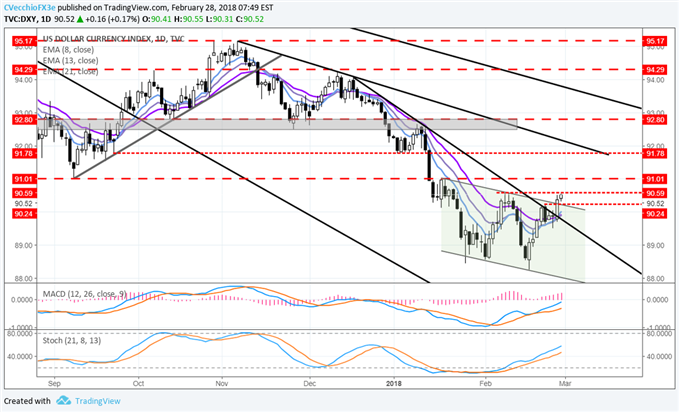Talking Points
- The DXY Index has cleared its downtrend from mid-December as well as the descending channel in place from mid-January; no longer is a broad USD-bearish bias appropriate.
- The Japanese Yen remains strong despite the greenback's advances; pairs like AUD/JPY, CAD/JPY, and EUR/JPY remain under pressure, with bearish momentum accelerating.
- Retail trader sentiment suggests a mixed trading environment for the US Dollar.
Looking to improve your trading results? Review the Traits of Successful Traders series to learn more.
The US Dollar (via DXY Index), sparked by new Fed Chair Jerome Powell's testimony, has showed signs of finally emerging from a potential bottom. Price closed above two key trend levels yesterday: the downtrend from the December 18, January 11, and now February 21 highs; as well as the descending channel top off of the January 17 and February 8 highs.
Price Chart 1: DXY Index Daily Timeframe (August 2017 to February 2018)

While this may mean that a broad USD-bearish bias is no longer applicable, we're still of the mindset that a true bottom can't be called until the DXY Index clears out 91.01, the former 2017 low and swing highs from mid-January.
In turn, it's best to look at USD-pairs on a case-by-case basis if we are no longer applying a bearish bias in broad strokes. In particular, we're going to want to keep an eye on EUR/USD, which constitutes 57.6% of the DXY Index. A close through 91.01 in DXY, where there was a failed morning doji star candle cluster between January 15-17, corresponds with a move below 1.2365 in EUR/USD, where there was a failed evening doji start candle cluster during that same period in mid-January.
One currency sticks out among the rest, however, given price action yesterday and during the month of February, generally: the Japanese Yen. The prospect of tigther Fed monetary policy proved to be a negative development for higher yielding currencies and risk-correlated assets. Notably, AUD/JPY and CAD/JPY continue to trade lower against their daily 8-EMAs, while EUR/JPY has broken significant support dating back to September.
See the above video for technical considerations in the DXY Index, EUR/USD, USD/CHF, USD/CAD, AUD/JPY, CAD/JPY, and EUR/JPY.
Read more: US Dollar Waits on New Fed Chair Powell - Expectations are Low
In an environment where volatility has picked up, it is absolutely imperative that traders adjust their risk management perspective. If you haven't yet, it's the right time to review the Traits of Successful Traders series in order to become reacquainted with the tenets of risk management.
--- Written by Christopher Vecchio, CFA, Senior Currency Strategist
To contact Christopher, email him at cvecchio@dailyfx.com.
Follow him in the DailyFX Real Time News feed and Twitter at @CVecchioFX.
To receive this analyst’s reports, sign up for his distribution list.
Don’t trade FX but want to learn more? Read the DailyFX Trading Guides.







